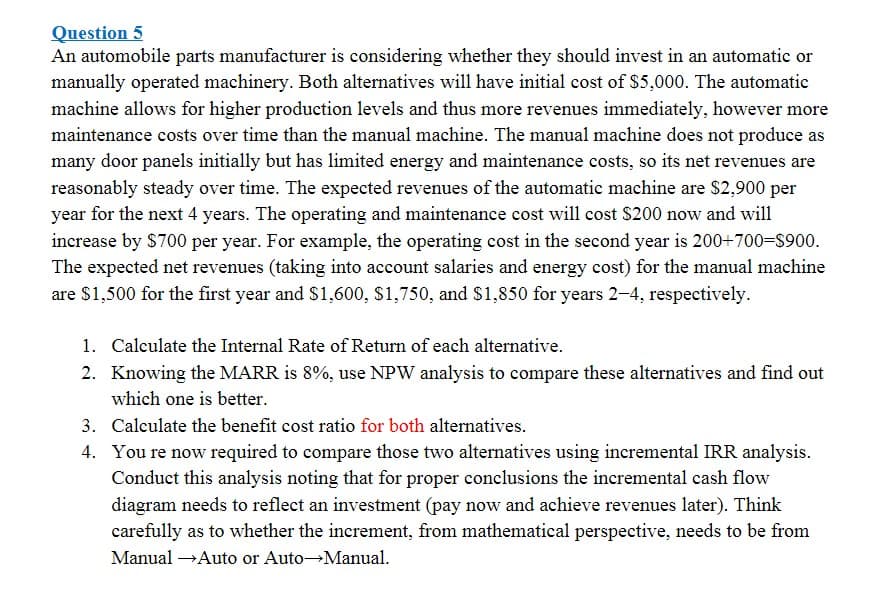Question 5 An automobile parts manufacturer is considering whether they should invest in an automatic or manually operated machinery. Both alternatives will have initial cost of $5,000. The automatic machine allows for higher production levels and thus more revenues immediately, however more maintenance costs over time than the manual machine. The manual machine does not produce as many door panels initially but has limited energy and maintenance costs, so its net revenues are reasonably steady over time. The expected revenues of the automatic machine are $2,900 per year for the next 4 years. The operating and maintenance cost will cost $200 now and will increase by $700 per year. For example, the operating cost in the second year is 200+700=$900. The expected net revenues (taking into account salaries and energy cost) for the manual machine are $1,500 for the first year and S1,600, $1,750, and $1,850 for years 2-4, respectively. 1. Calculate the Internal Rate of Return of each alternative. 2. Knowing the MARR is 8%, use NPW analysis to compare these alternatives and find out which one is better. 3. Calculate the benefit cost ratio for both alternatives.
Question 5 An automobile parts manufacturer is considering whether they should invest in an automatic or manually operated machinery. Both alternatives will have initial cost of $5,000. The automatic machine allows for higher production levels and thus more revenues immediately, however more maintenance costs over time than the manual machine. The manual machine does not produce as many door panels initially but has limited energy and maintenance costs, so its net revenues are reasonably steady over time. The expected revenues of the automatic machine are $2,900 per year for the next 4 years. The operating and maintenance cost will cost $200 now and will increase by $700 per year. For example, the operating cost in the second year is 200+700=$900. The expected net revenues (taking into account salaries and energy cost) for the manual machine are $1,500 for the first year and S1,600, $1,750, and $1,850 for years 2-4, respectively. 1. Calculate the Internal Rate of Return of each alternative. 2. Knowing the MARR is 8%, use NPW analysis to compare these alternatives and find out which one is better. 3. Calculate the benefit cost ratio for both alternatives.
Managerial Accounting
15th Edition
ISBN:9781337912020
Author:Carl Warren, Ph.d. Cma William B. Tayler
Publisher:Carl Warren, Ph.d. Cma William B. Tayler
Chapter12: Capital Investment Analysis
Section: Chapter Questions
Problem 13E
Related questions
Question
Please don't copy from chegg and show formulas

Transcribed Image Text:Question 5
An automobile parts manufacturer is considering whether they should invest in an automatic or
manually operated machinery. Both alternatives will have initial cost of $5,000. The automatic
machine allows for higher production levels and thus more revenues immediately, however more
maintenance costs over time than the manual machine. The manual machine does not produce as
many door panels initially but has limited energy and maintenance costs, so its net revenues are
reasonably steady over time. The expected revenues of the automatic machine are $2,900 per
year for the next 4 years. The operating and maintenance cost will cost $200 now and will
increase by $700 per year. For example, the operating cost in the second year is 200+700=S900.
The expected net revenues (taking into account salaries and energy cost) for the manual machine
are $1,500 for the first year and S1,600, $1,750, and $1,850 for years 2-4, respectively.
1. Calculate the Internal Rate of Return of each alternative.
2. Knowing the MARR is 8%, use NPW analysis to compare these alternatives and find out
which one is better.
3. Calculate the benefit cost ratio for both alternatives.
4. You re now required to compare those two alternatives using incremental IRR analysis.
Conduct this analysis noting that for proper conclusions the incremental cash flow
diagram needs to reflect an investment (pay now and achieve revenues later). Think
carefully as to whether the increment, from mathematical perspective, needs to be from
Manual →Auto or Auto Manual.
Expert Solution
This question has been solved!
Explore an expertly crafted, step-by-step solution for a thorough understanding of key concepts.
Step by step
Solved in 6 steps with 4 images

Recommended textbooks for you

Managerial Accounting
Accounting
ISBN:
9781337912020
Author:
Carl Warren, Ph.d. Cma William B. Tayler
Publisher:
South-Western College Pub

Intermediate Financial Management (MindTap Course…
Finance
ISBN:
9781337395083
Author:
Eugene F. Brigham, Phillip R. Daves
Publisher:
Cengage Learning


Managerial Accounting
Accounting
ISBN:
9781337912020
Author:
Carl Warren, Ph.d. Cma William B. Tayler
Publisher:
South-Western College Pub

Intermediate Financial Management (MindTap Course…
Finance
ISBN:
9781337395083
Author:
Eugene F. Brigham, Phillip R. Daves
Publisher:
Cengage Learning


Principles of Accounting Volume 2
Accounting
ISBN:
9781947172609
Author:
OpenStax
Publisher:
OpenStax College

Principles of Cost Accounting
Accounting
ISBN:
9781305087408
Author:
Edward J. Vanderbeck, Maria R. Mitchell
Publisher:
Cengage Learning